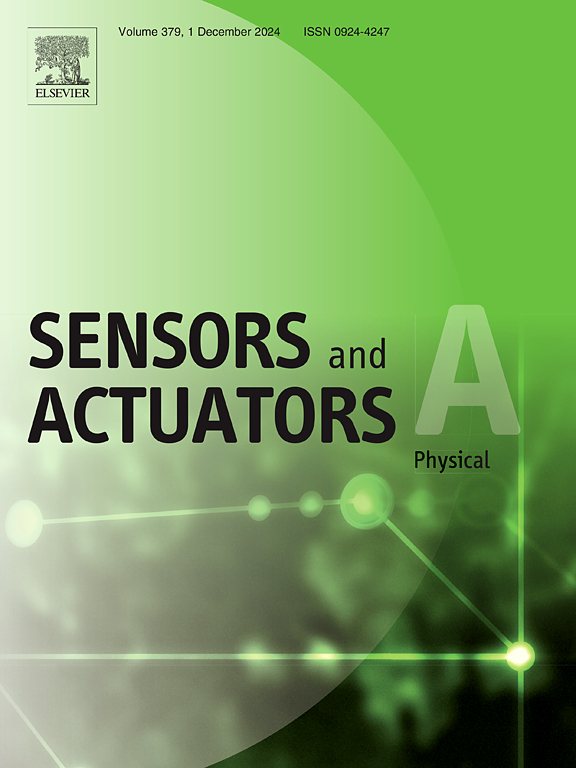Hybrid structured wearable flexible piezoresistive sensor with high sensitivity and wide detection range
IF 4.1
3区 工程技术
Q2 ENGINEERING, ELECTRICAL & ELECTRONIC
引用次数: 0
Abstract
Flexible pressure sensors are indispensable in various applications, such as intelligent soft robots and wearable devices. However, developing low-cost, facile, flexible pressure sensors with high sensitivity and a wide detection range remains a great challenge. Here, we propose a simple and cost-effective flexible piezoresistive pressure sensor with a hybrid structure to obtain high sensitivity and a wide detection range. The hybrid structure is composed of micro cilia induced by a magnetic field and a porous polydimethylsiloxane (PDMS) structure using NaCl as a porogen. In contrast, multi-walled carbon nanotubes (MWCNTs) were used as a conductive coating. The synergistic effect of micro cilia and porous structure in the sensor achieved a maximum sensitivity of 13.16 kPa−1 (approximately 21 times higher than that of the porous structure alone), a wide detection range (0–100 kPa), a rapid response time (∼118 ms), a low limit of detection (0.49 Pa), and long-term durability (>10000 cycles). The sensor also exhibits remarkable stability after 1500 cycles in 90 % RH environments. Moreover, the practical application of the sensor in detecting complex human motions and health monitoring is demonstrated, validating its potential for applications in wearable devices.
高灵敏度、宽探测范围的混合结构可穿戴柔性压阻式传感器
柔性压力传感器在智能软机器人、可穿戴设备等各种应用中都是必不可少的。然而,开发低成本、轻便、灵活、高灵敏度、宽检测范围的压力传感器仍然是一个巨大的挑战。在此,我们提出了一种简单且具有成本效益的混合结构柔性压阻压力传感器,以获得高灵敏度和宽检测范围。该杂化结构由磁场诱导的微纤毛和以NaCl为孔隙剂的多孔聚二甲基硅氧烷(PDMS)结构组成。而采用多壁碳纳米管(MWCNTs)作为导电涂层。传感器中微纤毛和多孔结构的协同效应实现了13.16 kPa−1的最大灵敏度(约为单独多孔结构的21倍),宽检测范围(0-100 kPa),快速响应时间(~ 118 ms),低检测极限(0.49 Pa)和长期耐用(>;10000次循环)。该传感器在90 % RH环境中1500次循环后也表现出显著的稳定性。此外,还展示了该传感器在检测复杂人体运动和健康监测方面的实际应用,验证了其在可穿戴设备中的应用潜力。
本文章由计算机程序翻译,如有差异,请以英文原文为准。
求助全文
约1分钟内获得全文
求助全文
来源期刊

Sensors and Actuators A-physical
工程技术-工程:电子与电气
CiteScore
8.10
自引率
6.50%
发文量
630
审稿时长
49 days
期刊介绍:
Sensors and Actuators A: Physical brings together multidisciplinary interests in one journal entirely devoted to disseminating information on all aspects of research and development of solid-state devices for transducing physical signals. Sensors and Actuators A: Physical regularly publishes original papers, letters to the Editors and from time to time invited review articles within the following device areas:
• Fundamentals and Physics, such as: classification of effects, physical effects, measurement theory, modelling of sensors, measurement standards, measurement errors, units and constants, time and frequency measurement. Modeling papers should bring new modeling techniques to the field and be supported by experimental results.
• Materials and their Processing, such as: piezoelectric materials, polymers, metal oxides, III-V and II-VI semiconductors, thick and thin films, optical glass fibres, amorphous, polycrystalline and monocrystalline silicon.
• Optoelectronic sensors, such as: photovoltaic diodes, photoconductors, photodiodes, phototransistors, positron-sensitive photodetectors, optoisolators, photodiode arrays, charge-coupled devices, light-emitting diodes, injection lasers and liquid-crystal displays.
• Mechanical sensors, such as: metallic, thin-film and semiconductor strain gauges, diffused silicon pressure sensors, silicon accelerometers, solid-state displacement transducers, piezo junction devices, piezoelectric field-effect transducers (PiFETs), tunnel-diode strain sensors, surface acoustic wave devices, silicon micromechanical switches, solid-state flow meters and electronic flow controllers.
Etc...
 求助内容:
求助内容: 应助结果提醒方式:
应助结果提醒方式:


